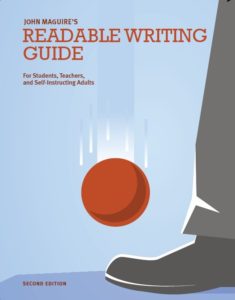The lady from the entrepreneurship group was on the phone yesterday and she asked, “Have you shown your book to the English departments?”
“No,” I said, “they’re not interested. The department heads are resigned to the idea that today’s kids are semi-literate and nothing much can be done about that. When you are selling a product, you are selling pain relief, right? I know that’s what your group says, and it’s true. In this domain, the pain point is the individual instructor, not the head of the English department.”
She was silent.
“It’s the individual instructor who feels that pain and frustration because though the kids are improving their writing, it’s so slow. The instructors feel the pain of that. Most department chairs are above it. ”
“I can see you’ve done your homework,” she said.
“I’m not sure that being in the small business enterprise group will help me. Yes, I want to sell books, but I am not so much in the business of selling books as I am trying to change the way freshman composition is taught. Everywhere. This is a method that really works and I want to see it adopted.”
“You see yourself as a thought leader.”
“A little bit, yes.” I agreed to think more about joining the entrepreneur group, and she hung up.
I now put the following questions out to the small band of teachers who believe in this method and are using it: What should I do next? What should we do next? What’s to be done?
Here’s what I am doing:
- I am speaking wherever possible. Later this month I’ll speak at the Alliance for Liberal Learning conference in Chicago (October 29th, Pinstripes restaurant).
- I’m giving out the occasional sample copy of the CWG.
- I have set these three goals for the next eight weeks:
- To spread the word about the method
- To ask instructors to assign the book as a text
- To improve the product itself
The “product” right now is the CWG with two supplements. The first supplement is a full answer key with answers for every single assignment or suggestion in the book. It’s available as a pdf to anyone who asks for it. The second supplement is a set of 39 one-page lesson plans that will convey the full course, both Part I and Part II; however it’s not finished. It’s my top writing priority this month.
The bottleneck in spreading the word right now is that teachers are ordering single copies to use as a resource book, but only a few are ordering the book in bulk for their courses. A set of lesson plans keyed closely to the book should help.
A new edition should have more student examples, better linked to the assignment language. It will also contain more combo assignments, that is, assignments where several skills are combined and practiced at once. It’s the combo assignments that distinguish this course and help students to construct useful writing habits fast. Without combo assignments, student progress slows a lot.
The insiders know the theory of the course: that writing is a presented as a single complex skill, built up from simpler skills that are properly combined. It’s like bicycle riding. To ride a two-wheeler requires learning distinct skills and then combining them. In bike riding there are six skills: mounting, pedaling, steering, balancing, braking and dismounting. In writing at the sentence level it’s concrete noun use, people language, active verbs, sentence length control, and conciseness. Later at the essay level it’s title, beginning, forecast sentence, body paragraphs organized with tags, and ending.
The reason we need more combo assignments is obvious: though the sub-skills are introduced one at a time, they must not remain separate. They have to be pulled into a single performance the way pedaling, steering and balancing are combined in bike riding.
So into the future. For my part, there’s the talk in Chicago and the lesson plans. I will report when the lesson plans are done.
For your part, if you like the CWG, spread the word. I will send examination copies to your teaching friends if you ask. You could also get me invited to speak at your institution.
If you don’t like the CWG so much, please, please send an email and tell me where it let you down; I’ll change and fix it if I can. As we all say to our writing students, “Anything can be improved.”

